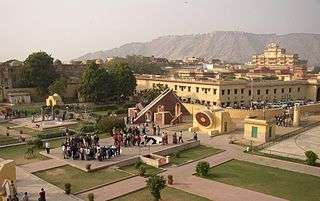Jaipur
Jaipur (/ˈdʒaɪpʊər/ (![]()
Jaipur | |
|---|---|
 | |
| Nickname(s): The Pink City | |
 Jaipur Location of Jaipur in Rajasthan  Jaipur Jaipur (India) | |
| Coordinates: 26.9°N 75.8°E | |
| Country | India |
| State | Rajasthan |
| District | Jaipur |
| Establishment | 1727 |
| Founded by | Jai Singh II |
| Named for | Jai Singh II |
| Government | |
| • Type | Municipal Corporation |
| • Body | Jaipur Nagar Nigam |
| • Mayor | Vishnu Laata[1] |
| Area | |
| • Total | 467 km2 (180 sq mi) |
| Area rank | 1st in Rajasthan |
| Elevation | 431 m (1,414 ft) |
| Population (2011)[3] | |
| • Total | 3,046,189 |
| • Rank | 10th India |
| • Density | 6,500/km2 (17,000/sq mi) |
| Demonym(s) | Jaipuri |
| Language | |
| • Official | Hindi[4] |
| • Additional official | English[4] |
| • Regional | Dhundari[5] |
| Time zone | UTC+05:30 (IST) |
| Pincode(s) | 3020xx |
| Area code(s) | +91-141 |
| Vehicle registration | RJ-14 (Jaipur South) RJ-45 (Jaipur North) RJ-52 (Shahpura) RJ-41 (Chomu) RJ-47 (Dudu) RJ-32 (Kotputli) |
| Website | jaipurmc |
| Official name | Jaipur City, Rajasthan |
| Criteria | Cultural: (ii), (iv), (vi) |
| Designated | 2019 (43rd session) |
| Reference no. | 1605 |
| State Party | India |
| Region | Southern Asia |
Jaipur was founded in 1727 by the Rajput ruler Jai Singh II,[9] the ruler of Amer, after whom the city is named. It was one of the earliest planned cities of modern India, designed by Vidyadhar Bhattacharya.[10] During the British Colonial period, the city served as the capital of Jaipur State. After independence in 1947, Jaipur was made capital of the newly-formed state of Rajasthan.
Jaipur is a popular tourist destination in India and forms a part of the west Golden Triangle tourist circuit along with Delhi and Agra (240 km, 149 mi).[11] It also serves as a gateway to other tourist destinations in Rajasthan such as Jodhpur (348 km, 216 mi), Jaisalmer (571 km, 355 mi), Udaipur (421 km, 262 mi), Kota (252 km, 156 mi) and Mount Abu (520 km, 323 mi). Jaipur is located 616 km from Shimla.
On 6 July 2019, UNESCO World Heritage Committee inscribed Jaipur the ‘Pink City of India’ among its World Heritage Sites.[12] The city is also home to the UNESCO World Heritage Sites Amber Fort and Jantar Mantar.
History
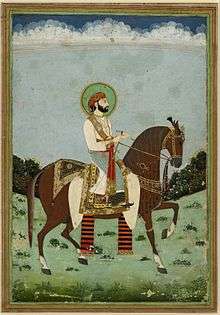
The city of Jaipur was founded in 1727 by Jai Singh II, the King of Amer who ruled from 1699 to 1743. He planned to shift his capital from Amer, 11 kilometres (7 mi) to Jaipur to accommodate the growing population and increasing scarcity of water.[10] Jai Singh consulted several books on architecture and architects while planning the layout of Jaipur. Under the architectural guidance of Vidyadhar Bhattacharya, Jaipur was planned based on the principles of Vastu Shastra and Shilpa Shastra.[13] The construction of the city began in 1726 and took four years to complete the major roads, offices, and palaces. The city was divided into nine blocks, two of which contained the state buildings and palaces, with the remaining seven allotted to the public. Huge ramparts were built, pierced by seven fortified gates.[10]
During the rule of Sawai Ram Singh I, the city was painted pink to welcome HRH Albert Edward, Prince of Wales (who later became King Edward VII, Emperor of India), in 1876.[14] Many of the avenues remained painted in pink, giving Jaipur a distinctive appearance and the epithet Pink city.[15]
In the 19th century, the city grew rapidly and by 1900 it had a population of 160,000. The wide boulevards were paved and its chief industries were the working of metals and marble, fostered by a school of art founded in 1868.[9] The city had three colleges, including a Sanskrit college (1865) and a girls' school (1867) opened during the reign of the Maharaja Ram Singh II.[16][17]
Large areas of the city including the airport were flooded in August 1981, resulting in the death of eight people and much damage to the city's Dravyavati River.[18] The floods were caused by three days of cloud burst that produced more rain than the annual average.[19]
Geography
Climate
Jaipur has a monsoon influenced hot semi-arid climate (Köppen climate classification BSh) with long, extremely hot summers and short, mild to warm winters. Annual precipitation is over 63 cm, falling mostly in July and August due to monsoon, causing the average temperatures in these two months to be lower compared to drier May and June. During the monsoon, there are frequent, heavy rains and thunderstorms, but flooding is not common. The highest temperature ever recorded was 48.5 °C (119.3 °F), in May. The city's average temperature remains below 20 °C or 68 °F between December and February. These months are mild, dry and pleasant, sometimes chilly. The lowest temperature ever recorded was −2.2 °C (28.0 °F). Jaipur, like many other major cities of the world, is a significant urban heat island zone with surrounding rural temperatures occasionally falling below freezing in winters.[20]
Climate data for Jaipur (Jaipur International Airport) 1981–2010, extremes 1952–2012 | |||||||||||||
|---|---|---|---|---|---|---|---|---|---|---|---|---|---|
| Month | Jan | Feb | Mar | Apr | May | Jun | Jul | Aug | Sep | Oct | Nov | Dec | Year |
| Record high °C (°F) | 31.7 (89.1) |
36.7 (98.1) |
42.8 (109.0) |
44.9 (112.8) |
48.5 (119.3) |
47.2 (117.0) |
46.7 (116.1) |
41.7 (107.1) |
41.7 (107.1) |
40.0 (104.0) |
36.4 (97.5) |
31.5 (88.7) |
48.5 (119.3) |
| Average high °C (°F) | 22.6 (72.7) |
25.7 (78.3) |
31.6 (88.9) |
37.4 (99.3) |
40.7 (105.3) |
39.6 (103.3) |
34.6 (94.3) |
32.7 (90.9) |
34.2 (93.6) |
33.8 (92.8) |
29.3 (84.7) |
24.5 (76.1) |
32.2 (90.0) |
| Average low °C (°F) | 8.6 (47.5) |
11.4 (52.5) |
16.8 (62.2) |
22.2 (72.0) |
26.5 (79.7) |
27.7 (81.9) |
26.1 (79.0) |
24.8 (76.6) |
23.6 (74.5) |
19.6 (67.3) |
14.0 (57.2) |
9.5 (49.1) |
19.2 (66.6) |
| Record low °C (°F) | −2.2 (28.0) |
−2.2 (28.0) |
3.3 (37.9) |
9.4 (48.9) |
15.6 (60.1) |
19.1 (66.4) |
20.6 (69.1) |
18.9 (66.0) |
15.0 (59.0) |
11.1 (52.0) |
3.3 (37.9) |
0.0 (32.0) |
−2.2 (28.0) |
| Average rainfall mm (inches) | 5.9 (0.23) |
9.3 (0.37) |
4.5 (0.18) |
5.8 (0.23) |
18.3 (0.72) |
51.4 (2.02) |
179.4 (7.06) |
190.2 (7.49) |
66.6 (2.62) |
25.8 (1.02) |
3.4 (0.13) |
4.2 (0.17) |
564.8 (22.24) |
| Average rainy days | 0.6 | 0.9 | 0.6 | 0.8 | 1.6 | 3.7 | 9.3 | 8.9 | 4.0 | 1.3 | 0.3 | 0.3 | 32.4 |
| Average relative humidity (%) (at 17:30 IST) | 37 | 29 | 21 | 17 | 19 | 33 | 60 | 67 | 50 | 31 | 34 | 39 | 36 |
| Source: India Meteorological Department[21][22] | |||||||||||||
Demographics
According to provisional report of 2011 census, Jaipur city had a population of 3,073,350.[23] The overall literacy rate for the city is 84.34%. 90.61% males and 77.41% females were literate.[23] The sex ratio was 898 females per 1,000 males. The child sex ratio stood at 854.[23] According to the 2011 census, Hindus form the majority religious group comprising 77.9% of the city's population, followed by Muslims (18.6%), Jains (2.4%) and others (1.2%).[24]
| Population Growth of Jaipur City | |||
|---|---|---|---|
| Census | Population | %± | |
| 1881 | 142,600 | — | |
| 1891 | 158,900 | 11.4% | |
| 1901 | 160,000 | 0.7% | |
| 1911 | 137,100 | −14.3% | |
| 1921 | 120,200 | −12.3% | |
| 1931 | 144,200 | 20.0% | |
| 1941 | 175,800 | 21.9% | |
| 1951 | 291,000 | 65.5% | |
| 1961 | 403,400 | 38.6% | |
| 1971 | 636,800 | 57.9% | |
| 1981 | 1,004,700 | 57.8% | |
| 1991 | 1,518,200 | 51.1% | |
| 2001 | 2,322,575 | 53.0% | |
| 2011 | 3,073,350 | 32.3% | |
| Source:Census of India[25][26][23] | |||
Administration and politics

Jaipur Municipal Corporation is responsible for maintaining the city's civic infrastructure and carrying out associated administrative duties. The Municipal Corporation is headed by a mayor.[27] There are 91 wards and each ward is represented by an elected member. Jaipur Development Authority (JDA) is the nodal government agency responsible for the planning and development of Jaipur.[28] Jaipur consists of two parliamentary constituencies Jaipur and Jaipur Rural.[29] In January 2019 Vishnu Laata was elected Mayor of Jaipur.[1]
Tourism
Jaipur is a major tourist destination in India forming a part of the Golden Triangle.[30] In the 2008 Conde Nast Traveller Readers Choice Survey, Jaipur was ranked the 7th best place to visit in Asia.[31] According to TripAdvisor's 2015 Traveller's Choice Awards for Destination, Jaipur ranked 1st among the Indian destinations for the year.[32] The Presidential Suite at the Raj Palace Hotel, billed at US$45,000 per night, was listed in second place on CNN's World's 15 most expensive hotel suites in 2012.[33]
Jaipur Exhibition & Convention Centre (JECC) is Rajasthan's biggest convention and exhibition centre.[34] It is famous for organising events such as Vastara, Jaipur Jewellery Show, Stonemart 2015 and Resurgent Rajasthan Partnership Summit 2015.[35]
Visitor attractions include the Albert Hall Museum, Hawa Mahal, Jal Mahal, City Palace, Amer Fort, Jantar Mantar, Nahargarh Fort, Jaigarh Fort, Birla Mandir, Galtaji, Govind Dev Ji Temple, Garh Ganesh Temple, Moti Dungri Ganesh Temple, Sanghiji Jain temple and the Jaipur Zoo.[36] The Jantar Mantar observatory and Amer Fort are one of the World Heritage Sites.[37] Hawa Mahal is a five-storey pyramidal shaped monument with 953 windows[38] that rises 15 metres (50 ft) from its high base. Sisodiya Rani Bagh and Kanak Vrindavan are the major parks in Jaipur.[39] Raj Mandir is a notable cinema hall in Jaipur.
Culture
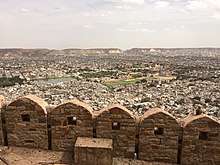
Jaipur has many cultural sites like Jawahar Kala Kendra formed by Architect Charles Correa and Ravindra Manch. Government Central Museum hosts several arts and antiquities. There is a government museum at Hawa Mahal and an art gallery at Viratnagar. There are statues depicting Rajasthani culture around the city.[40][41] Jaipur has many traditional shops selling antiques and handicrafts, as well as contemporary brands reviving traditional techniques, such as Anokhi. The prior rulers of Jaipur patronised a number of arts and crafts. They invited skilled artisans, artists and craftsmen from India and abroad who settled in the city. Some of the crafts include bandhani, block printing, stone carving and sculpture, tarkashi, zari, gota-patti, kinari and zardozi, silver jewellery, gems, kundan, meenakari and jewellery, Lakh ki Chudiya, miniature paintings, blue pottery, ivory carving, shellac work and leather ware.[42][39]
Jaipur has its own performing arts. The Jaipur Gharana for Kathak is one of the three gharanas of the major north Indian classical dance form of Kathak.[43] The Jaipur Gharana of Kathak is known for its rapid intricate dance forms, vivacious body movements and subtle Abhinaya.[43] The Ghoomar is a popular folk dance style.[44][45][46] Tamasha is an art form where Kathputli puppet dance is shown in play form.[47] Major festivals celebrated in Jaipur include Elephant Festival, Gangaur, Makar Sankranti, Holi, Diwali, Vijayadashami, Teej, Eid, Mahavir Jayanti and Christmas. Jaipur is also famous for the Jaipur Literature Festival, the world's largest free literature festival in which country-wide authors, writers and literature lovers participate.[48]
Architecture
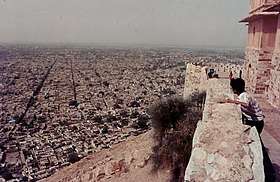
The city was planned according to the Indian Vastu shastra by Vidyadhar Bhattacharya in 1727.[49] There are three gates facing east, west, and north. The eastern gate is called Suraj pol (sun gate), the western gate is called Chand pol (moon gate) and the northern gate faces the ancestral capital of Amer.[13][50]
The city is unusual among pre-modern Indian cities in the regularity of its streets, and the division of the city into six sectors by broad streets 34 m (111 ft) wide. The urban quarters are further divided by networks of gridded streets. Five-quarters wrap around the east, south, and west sides of a central palace quarter, with a sixth quarter immediately to the east. The Palace quarter encloses the Hawa Mahal palace complex, formal gardens, and a small lake. Nahargarh Fort, which was the residence of the King Sawai Jai Singh II, crowns the hill in the northwest corner of the old city.[39]
Cuisine
Typical dishes include Dal Baati Churma, Missi Roti, Gatte ki Sabzi, Lahsun ki chutney, Ker Sangri, Makke ki Ghat, Bajre ki Ghat, Bajre ki Roti and Laal Maans.[51] Jaipur is also known for its sweets which include Ghevar, Feeni, Mawa Kachori, Gajak, Meethi thuli, Chauguni ke laddu, and Moong Thal.[52][53]
Economy and infrastructure
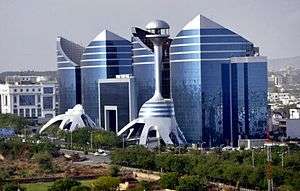
In addition to its role as the provincial capital, educational, and administrative centre, the economy of Jaipur is fuelled by tourism, gemstone cutting, the manufacture of jewellery and luxury textiles, and information technology.[54] Three major trade promotion organisations have their offices in Jaipur. These are: Federation of Indian Chambers of Commerce & Industry, (FICCI) the PHD Chamber of Commerce and Industry (PHDCCI) and the Confederation of Indian Industry (CII) which has its regional offices here. In 2008, Jaipur was ranked 31 among the 50 Emerging Global Outsourcing cities.[55] Jaipur Stock Exchange is one of the regional stock exchanges in India and was founded in 1989.[56] Jaipur is a major hub for arts and crafts. It has many traditional shops selling antiques, jewellery, handicrafts, gems, bangles, pottery, carpets, textiles, leather and metal products. Jaipur is one of India's largest manufacturers of hand-knotted rugs.[57][58] Jaipur leg, a rubber-based prosthetic leg for people with below-knee amputations, was designed and is produced in Jaipur.[59][60]
Communication
Jaipur has offices of companies like Airtel, Vodafone, Jio, Reliance, Idea, BSNL, V-Guard and Tata which are providing mobile telephony and there are also various internet service providers in the city. The government of Rajasthan has started free WiFi at various public places like Central Park, Jantar Mantar among others.
Media
Major daily newspapers in Jaipur include Amar Ujala,[61] Rajasthan Patrika, Dainik Bhaskar, Dainik Navajyoti and The Times of India.[62] The state-owned All India Radio is broadcast both on the medium wave and FM band in the city. Private FM stations include Radio Mirchi (98.3 MHz), Radio City (91.1 MHz), My FM (94.3 MHz), FM Tadka 95 FM (95.0 MHz), Red FM 93.5 (93.5 MHz) and Gyan Vani (105.6 MHz). The city has a community FM channel in FM Radio 7 (90.4 MHz) by India International School Institutional Network. The public broadcaster Doordarshan (Prasar Bharati) provides a regional channel in addition to the private broadcasters.
Transport
Roads
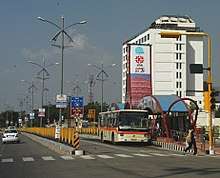
Jaipur is located on National Highway No.8 connecting Delhi and Mumbai. National Highway 12 links Jaipur with Kota and National Highway 11 links Bikaner with Agra passing through Jaipur. RSRTC operates bus service to major cities in Rajasthan, New Delhi, Uttar Pradesh, Haryana, Madhya Pradesh, Maharashtra, Punjab and Gujarat. City buses are operated by Jaipur City Transport Services Limited (JCTSL)[64] of RSRTC.[65] The service operates more than 400 regular and low-floor buses. Major bus depots are located at Vaishali Nagar, Vidyadhar Nagar and Sanganer.
Jaipur BRTS was approved by the government in August 2006. Jaipur BRTS is managed by JCSTL, a special purpose vehicle formed by Jaipur Development Authority and Jaipur Nagar Nigam. In Phase I, two corridors have been proposed: a "North-South Corridor" from Sikar Road to Tonk Road and an "East-West Corridor" from Ajmer Road to Delhi Road. A section of the North-South Corridor from bypass near Harmada to Pani Pech became operational in 2010.[66][66][67]
Jaipur Ring Road is a project of Jaipur Development Authority to reduce increasing traffic of Jaipur city[68] which connects NH-11 (Agra Road), NH-8 (Ajmer Road), NH-12 (Tonk Road), and NH-12 (Malpura Road) having a length of 150 km.[69] The 57 km out of 150 km long six-lane Jaipur Ring Road has been completed at a cost of Rs 1217 crore which was inaugurated by Sushma Swaraj, Arun Jaitley and Nitin Gadkari.
Rail
Jaipur is the headquarters of North Western Zone of Indian Railways.[70] Jaipur Junction railway station is well connected to all major cities of India like Delhi, Mumbai, Hyderabad, Kolkata, Chennai, Bengaluru, Indore, Lucknow, Visakhapatnam and Ahmedabad. Other stations include Gandhinagar, Durgapura, Jagatpura, Ninad Benad and Sanganer.
Metro
Jaipur Metro commenced commercial operation on 3 June 2015.[71] Phase-1A is operational between Mansarovar and Chandpole consisting of nine stations namely Mansarovar, New Aatish Market, Vivek Vihar, Shayam Nagar, Ram Nagar, Civil Line, Railway Station, Sindhi Camp and Chandpole.[72] Phase-1B is under construction. The estimated cost of the project is ₹550 crore (US$77 million)[73] and it is expected to be completed by 2020.[74]
Air
Jaipur International Airport is in Sanganer, 12.2 km (8 miles) from the centre. The airport handled 363,899 international and 2,540,451 domestic passengers in 2015–2016.[75] Jaipur Airport also provides air cargo services. During winter, sometimes flights towards Indira Gandhi International Airport are diverted to Jaipur Airport due to heavy fog in Delhi.[76] The airport operates regular domestic services to major Indian cities including Ahmedabad, Bengaluru, Chandigarh, Raipur, Chennai, Delhi, Guwahati, Hyderabad, Visakhapatnam, Indore, Kolkata, Lucknow, Mumbai, Pune, Surat, Udaipur and Varanasi. International destinations served include Dubai, Muscat, Bangkok, Sharjah and Kuala Lumpur.
Education
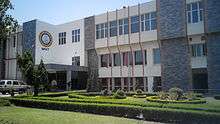
Public and private schools in Jaipur are governed by the Central Board of Secondary Education or Board of Secondary Education Rajasthan, International Board of education and follow a "10+2" plan. This plan entails eight years of primary education and four years of secondary education. Secondary school includes two years of upper secondary education, which is more specific and diverse than the two years of lower secondary education prior to it.[77] Languages of instruction include English and Hindi.
Admission to graduation colleges in Jaipur, many of which are affiliated to Rajasthan Technical University, is through the RPET, now RPET has been replaced by REAP (Rajasthan Engineering Admission Process). Notable institutions include SMS Medical College, St Xavier's College, University of Rajasthan,[78] Indian Institute of Health Management Research, Malviya National Institute of Technology Jaipur,[79][80] Jaipur National University,[81][82][83][84][85][86] Manipal University, The LNM Institute of Information Technology, IIS University,[87][88] and Suresh Gyan Vihar University[89]
Sports
The main cricket stadium in the city, Sawai Mansingh Stadium, has a seating capacity of 30,000 and has hosted national and international cricket matches.[90] Sawai Mansingh Indoor Stadium, Chaugan Stadium and Railway Cricket Ground are the other sporting arenas in the city.
A new stadium has been proposed for Chonp Village with seating capacity 75,000. It would be the third largest cricket stadium in the world after the Sardar Patel Stadium and the Melbourne Cricket Ground.
The city is represented in the IPL by Rajasthan Royals (2008-2016; 2018–present)[91][92] and in Pro Kabaddi League by Jaipur Pink Panthers.[93]
In popular culture
Paul McCartney wrote and recorded the Jaipur tribute song "Riding into Jaipur" (4:08) whose minimalist lyrics say: « riding to Jaipur, riding through the night, riding with my baby, oh what a delight, oh what a delight, it is. » The song was released on his 2001 studio album Driving Rain.
Jaipur is the setting for the film The Best Exotic Marigold Hotel and its sequel, The Second Best Exotic Marigold Hotel, which follow the adventures of a group of senior European expats who retire to Jaipur and in the process discover their true selves.
Sister cities
- Fremont, California, United States, since January 26, 1980
See also
References
- "Vishnu Laata, BJP's rebel councillor, defeats party candidate by 1 vote to become new Jaipur mayor". Archived from the original on 23 January 2019. Retrieved 23 January 2019.
- "City Profile". Jaipur Municipal Corporation. Archived from the original on 25 April 2018. Retrieved 24 April 2018.
- "District Census Handbook - Jaipur" (PDF). Census of India. p. 30. Archived (PDF) from the original on 14 November 2015. Retrieved 10 February 2016.
- "52nd REPORT OF THE COMMISSIONER FOR LINGUISTIC MINORITIES IN INDIA" (PDF). nclm.nic.in. Ministry of Minority Affairs. Archived from the original (PDF) on 25 May 2017. Retrieved 2 May 2019.
- "Glottolog 4.1 - Dhundari". glottolog.org. Retrieved 7 January 2020.
- "Jaipur City (or Jainagar)". The Imperial Gazetteer of India. 1909. pp. 399–402. Archived from the original on 26 May 2010. Retrieved 23 April 2010.
- "Define Jaipur". Dictionary.com. Archived from the original on 14 July 2014. Retrieved 26 June 2014.
- "Definition of Jaipur". The Free Dictionary. Archived from the original on 7 July 2014. Retrieved 26 June 2014.
- Chisholm, Hugh, ed. (1911). . Encyclopædia Britannica. 15 (11th ed.). Cambridge University Press. pp. 128–129.
- "About Jaipur". Government of Rajasthan. Archived from the original on 3 November 2015. Retrieved 5 November 2015.
- "The Complete Guide To: India's Golden Triangle". The Independent. 3 February 2007. Archived from the original on 30 December 2017. Retrieved 15 December 2017.
- "Seven cultural sites inscribed on UNESCO's World Heritage List". UNESCO. 6 July 2019.
- "Jaipur - The Pink City". Archived from the original on 17 July 2011. Retrieved 5 July 2011.
- "History of Jaipur". Lonely Planet. Archived from the original on 1 June 2016. Retrieved 26 April 2016.
- "History in depth: Edward VII: The First Constitutional Monarch". BBC. 5 November 2009. Archived from the original on 26 June 2007. Retrieved 26 July 2010.
- "Jaipur City or Jainagar". The Imperial Gazetteer of India. 1909. pp. 399–402. Archived from the original on 26 May 2010. Retrieved 23 April 2010.
- "Jaipur State". The Imperial Gazetteer of India. 1909. pp. 382–399. Archived from the original on 15 November 2015. Retrieved 5 November 2015.
- "Rejuvenation of Amanishah Nallah including Area Development" (PDF). Ministry of Environment, Forest and Climate Change. 5 May 2016. p. 25. Archived (PDF) from the original on 1 February 2018. Retrieved 31 January 2018.
- Jain, Sharad K.; Agarwal, Pushpendra K.; Singh, Vijay P. (2007). Hydrology and Water Resources of India. Springer Science & Business Media. p. 883. ISBN 9781402051807. Archived from the original on 1 February 2018. Retrieved 31 January 2018.
- "World Weather Information Service". Archived from the original on 28 November 2009. Retrieved 11 December 2009.
- "Station: Jaipur (Sanganer) Climatological Table 1981–2010" (PDF). Climatological Normals 1981–2010. India Meteorological Department. January 2015. pp. 343–344. Archived from the original (PDF) on 5 February 2020. Retrieved 19 March 2020.
- "Extremes of Temperature & Rainfall for Indian Stations (Up to 2012)" (PDF). India Meteorological Department. December 2016. p. M180. Archived from the original (PDF) on 5 February 2020. Retrieved 19 March 2020.
- "Provisional Population Totals, Census of India 2011; Cities having population 1 lakh and above" (PDF). Office of the Registrar General & Census Commissioner, India. Archived (PDF) from the original on 7 May 2012. Retrieved 26 March 2012.
- "Population By Religious Community - Rajasthan" (XLS). Office of The Registrar General and Census Commissioner, Ministry of Home Affairs, Government of India. 2011. Archived from the original on 13 September 2015. Retrieved 13 September 2015.
- "Census of India". mospi.gov.in. Archived from the original on 13 August 2008. Retrieved 23 June 2008.
- "Historical Census of India". Archived from the original on 17 February 2013. Retrieved 5 November 2015.
- "Jaipur MC". Jaipur MC. Archived from the original on 16 March 2015. Retrieved 7 March 2015.
- "Jaipur Development Authority". Government of Rajasthan. Archived from the original on 5 March 2016. Retrieved 5 November 2015.
- "Parliamentary & Assembly Constituencies wise Polling Stations & Electors" (PDF). Chief Electoral Officer, Rajasthan website. Archived from the original (PDF) on 26 July 2011. Retrieved 5 November 2015.
- Sharma, Aman (26 December 2019). "Air India's Jaipur-Agra flight suffering losses". The Economic Times. Retrieved 5 February 2020.
- "Jaipur Seventh Best Tourist Destination in Asia – Conde Nast Traveller Survey". bharatonline.com. Archived from the original on 18 July 2011. Retrieved 28 March 2011.
- "World's best destinations". Archived from the original on 1 April 2015. Retrieved 28 March 2011.
- Arnold, Helen (25 March 2012). "World's 15 most expensive hotel suites". CNN Go. Archived from the original on 2 November 2012. Retrieved 11 April 2012.
- "Accor to manage Jaipur's new convention centre". M&IT India. Archived from the original on 14 April 2016. Retrieved 8 February 2016.
- "Jaipur Exhibition and Convention Centre will make Pink City a meetings, incentives, conferences, and exhibitions hub - Times of India". The Times of India. Archived from the original on 11 July 2015. Retrieved 8 February 2016.
- "Temples of Jaipur". jaipur.org. Archived from the original on 24 November 2015. Retrieved 31 October 2015.
- "The Jantar Mantar, Jaipur – UNESCO World Heritage Centre". whc.unesco.org. 31 July 2010. Archived from the original on 5 October 2010. Retrieved 1 September 2010.
- "Hawa Mahal Jaipur - History, Architecture, Visiting Hours". www.jaipur.org.uk. Archived from the original on 4 March 2016. Retrieved 1 February 2016.
- "About Jaipur". Government of Rajasthan. Archived from the original on 14 June 2015. Retrieved 5 November 2015.
- "Culture Of Jaipur - Cultural Heritage, Art & Architecture of Jaipur". jaipur.org. Archived from the original on 5 July 2015. Retrieved 27 July 2015.
- "Culture of Jaipur". Archived from the original on 9 July 2017. Retrieved 8 March 2016.
- "Why Jaipur is called pink city". mapsofindia.com. Archived from the original on 19 October 2013. Retrieved 5 November 2015.
- "Jaipur Kathak Kendra: Home". jaipurkathakkendra.nic.in. Archived from the original on 24 October 2017. Retrieved 14 September 2017.
- Manorma Sharma (2006). Tradition of Hindustani Music. APH Publishing. pp. 49–51. ISBN 978-81-7648-999-7. Archived from the original on 18 March 2017. Retrieved 3 October 2016.
- Jeffrey Michael Grimes (2008). The Geography of Hindustani Music: The Influence of Region and Regionalism on the North Indian Classical Tradition. pp. 142–. ISBN 978-1-109-00342-0. Archived from the original on 17 March 2017. Retrieved 3 October 2016.
- Kumāraprasāda Mukhopādhyāẏa (2006). The Lost World of Hindustani Music. Penguin Books India. pp. 154–. ISBN 978-0-14-306199-1. Archived from the original on 18 March 2017. Retrieved 3 October 2016.
- "Culture of Jaipur". jaipur.org. Archived from the original on 5 July 2015. Retrieved 31 October 2015.
- "Jaipur literary festival". jaipur.org. Archived from the original on 17 October 2015. Retrieved 31 October 2015.
- "Vidyadhar Garden in Jaipur". Archived from the original on 13 May 2011. Retrieved 5 July 2011.
- Vibhuti Sachdev, Giles Henry Rupert Tillotson (2002). Building Jaipur: The Making of an Indian City. Oxford University Press. ISBN 978-0-19-566353-2. Archived from the original on 8 December 2015. Retrieved 5 November 2015.
- "Cuisines Of Jaipur". pinkcity.com. 5 December 2012. Archived from the original on 16 October 2015. Retrieved 31 October 2015.
- "Cuisine of Jaipur". Jaipur-pinkcity.webs.com. Archived from the original on 14 May 2011. Retrieved 28 March 2011.
- "What to eat in Jaipur". jaipurtravel.com. Archived from the original on 19 October 2015. Retrieved 31 October 2015.
- "IT & ITeS - Resurgent Rajasthan". resurgent.rajasthan.gov.in. Archived from the original on 10 June 2016. Retrieved 10 June 2016.
- "Indian cities among global outsourcing cities". The Economic Times. Archived from the original on 3 March 2009. Retrieved 23 September 2009.
- "JSEL". Archived from the original on 25 October 2015. Retrieved 31 October 2015.
- "Development through Enterprise". NextBillion.net. 26 May 2012. Archived from the original on 27 September 2011. Retrieved 2 June 2012.
- "Churu's Marwari, Nand Kishore Chaudhary's Jaipur Rugs a matter of discourse at Harvard". Economic Times. 26 January 2012. Archived from the original on 30 January 2012. Retrieved 24 February 2012.
- "Jaipur foot: History". jaipurfoot.org. Archived from the original on 26 October 2012. Retrieved 5 November 2015.
- "Padma Awards Directory (1954–2009)" (PDF). Ministry of Home Affairs. Archived from the original (PDF) on 10 May 2013. Retrieved 5 November 2015.
- "Jaipur News in Hindi". Amar Ujala. Archived from the original on 7 September 2017. Retrieved 7 September 2017.
- "Jaipur Guide". bhaskar.com. Archived from the original on 23 July 2015. Retrieved 27 July 2015.
- "JCSTL Website". Jaipurbus.com. Archived from the original on 26 February 2011. Retrieved 28 March 2011.
- "Rajasthan State Road Transportation Company info". India Transit. Archived from the original on 26 January 2013. Retrieved 4 December 2014.
- "BRTS – JDA Website". JDA. Archived from the original on 26 March 2011. Retrieved 28 March 2011.
- "Traffic Diversion and Flow During Construction of BRTS". Archived from the original on 16 October 2015. Retrieved 27 July 2015.
- "Development of New Express Highways". pib.gov.in. Retrieved 7 January 2020.
- Correspondent, dna (31 January 2019). "Jaipur Development Authority to commence land acquisition for Ring Road". DNA India. Retrieved 7 January 2020.
- "NW Railway". Indian Railways. Archived from the original on 11 August 2015. Retrieved 27 July 2015.
- "JMRC Notification for commercial operations of metro". Jaipur Metro. Archived from the original on 11 July 2015.
- "Metro Stations". jaipurmetrorail.in. Archived from the original on 18 May 2015. Retrieved 27 July 2015.
- "Jaipur Metro Phase-1B Estimated Cost". citi.co.in. Archived from the original on 11 December 2015. Retrieved 9 December 2015.
- "Work on Jaipur Metro 1B to start next year | Jaipur News - Times of India". The Times of India. Retrieved 7 January 2020.
- "Jaipur International Airport". Archived from the original on 14 June 2011. Retrieved 19 February 2011.
- "Flights diverted to Jaipur". Chennai, India: The Hindu. 18 February 2011. Archived from the original on 29 June 2011. Retrieved 19 February 2011.
- Clark, Nick (February 2006). "Education in India". World Education News + Reviews. World Education Services. Archived from the original on 5 February 2018. Retrieved 4 February 2018.
- "University of Rajasthan: An Overview". Archived from the original on 2 July 2014. Retrieved 30 June 2014.
- "The NIT Amendment Act, 2012" (PDF). mnnit.ac.in. Archived (PDF) from the original on 15 November 2015. Retrieved 24 July 2015.
- "Malaviya National Institute of Technology, Jaipur". Minglebox. Archived from the original on 19 May 2015. Retrieved 23 July 2015.
- "Jaipur National University". 4icu.org. Archived from the original on 25 October 2015. Retrieved 5 November 2015.
- "Association of Indian Universities". aiuweb.org. Archived from the original on 12 February 2015. Retrieved 12 February 2015.
- "University Grants Commission". ugc.ac.in. Archived from the original on 30 September 2015. Retrieved 5 November 2015.
- "All India Council for Technical Education" (PDF). AICTE. Archived (PDF) from the original on 15 November 2015. Retrieved 5 November 2015.
- "Distance Education Bureau" (PDF). UGC. Archived (PDF) from the original on 15 November 2015. Retrieved 5 November 2015.
- "National Accreditation and Assessment Council". NAAC. Archived from the original on 26 October 2015. Retrieved 5 November 2015.
- "The IIS University | ICG becomes THE IIS UNIVERSITY". iisuniv.ac.in. Archived from the original on 13 February 2016. Retrieved 8 February 2016.
- "India leads in the supply of youth globally – Dr Swamy". Changing Tomorrow. Archived from the original on 28 February 2016. Retrieved 8 February 2016.
- "UGC inspection report of sgvu, pg.5 claims Dr.Sudhanshu as Vice Chancellor and Founder" (PDF). Archived from the original (PDF) on 28 February 2013. Retrieved 7 January 2020.
- "Sawai Mansingh Stadium". worldstadiums.com. Archived from the original on 24 September 2011. Retrieved 5 November 2015.
- "Big business and Bollywood grab stakes in IPL". ESPNcricinfo. Archived from the original on 24 September 2018. Retrieved 24 January 2008.
- "The Return of the Royals". Retrieved 4 August 2019.
- "Big B, Aamir, SRK cheer for Abhishek's Pink Panthers". Mumbai. The Hindu. 27 July 2014. Retrieved 28 July 2014.
Further reading
- Bhatt, Kavi Shiromani; Shastry, Mathuranath (1948). Jaipur Vaibhawam (History of Jaipur written in Sanskrit). Re-published in 2002 by Kalanath Shastry, Manjunath Smriti Sansthan, Jaipur.
- Khangarot, R.S., Nathawat, P.S. (1990) Jaigarh- The Invincible Fort of Amer. RBSA Publishers, Jaipur.
- Sachdev, Vibhuti; Tillotson, Giles Henry Rupert (2002). Building Jaipur: The Making of an Indian City. Reaktion Books, London. ISBN 1-86189-137-7.
- Sarkar, Jadunath (1984). A History of Jaipur. Orient Longman Limited, New Delhi. ISBN 81-250-0333-9.
- Volwahsen, Andreas (2001). Cosmic Architecture in India: The Astronomical Monuments of Maharaja Jai Singh II, Prestel Mapin, Munich.
External links
| Wikimedia Commons has media related to Jaipur. |
| Wikiquote has quotations related to: Jaipur |
| Wikivoyage has a travel guide for Jaipur. |

.jpg)
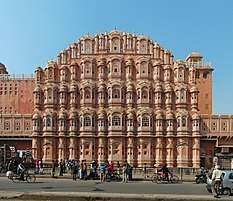


.jpg)
